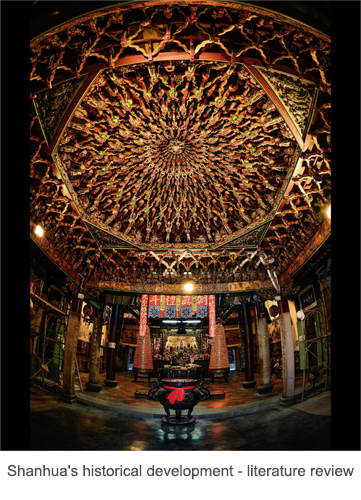
According to Nanying Caifong (Lands of Nanying), Shanhua Dis-trict was called Backloun Settlement during the Dutch colonial era. As the district was located next to Wanli River, the area was thus re-ferred to as Wanli Jie of Anping County in Tainan Prefecture during the Cing Administration and was governed by a Syunsi (provisional district official.) The Japanese occupation led to the establish-ment of civil administration over the district and designated the ar-ea as Wanli Benmusho of Tainan Ken (Wanli Administration Office of Tainan County). In 1897, the district was included as part of the Tavocan Benmusho and was renamed Wanli Benmu-Chisho (Wanli Branch Administration Office). In 1899, the Gai-sho-ku (ward, vil-lage, and district) system was established, dividing Shanhua Village into Eastern and Western Ku (districts). In 1920, regional admin-istration reforms were carried out. The Western Ku (district) was merged to form Shanhua Sho (Shanhua Village), and was later pro-moted to Shanhua Gai (Shanhua Ward) with a Gai Yakuba (Ward Of-fice) (1940). After the Second World War, the area was renamed as Shanhua Township. On 25 December, 2010, the area was promoted to Shanhua District of Tainan City.
According to the Overall Urban Planning Evaluation Report of Shanhua, Shanhua was known in the old days as Wanli. In the 9th year of the Japanese Emperor Taisho (1920), the district was re-named as Shanhua-Sho (Shanhua Village). The area was promoted to Shanhua-Gai (Shanhua Ward) in the 15th year of Japanese Em-peror Showa (1940). After the Second World War ended, the area was again renamed as Shanhua Township. In the county and city merger that created the Tainan City municipality on 25 December, 2010, the area was once more promoted to form Shanhua District. Under the reign of Prince Jheng Cheng-gong, the area was man-aged according to military-farming settlement policies, with both settlers and Pingpu people living together in the area. They then at-tracted many merchants and traders as well. In the 11th year of the Japanese Emperor Showa (1936), administrative structure was re-vised. Transport routes were expanded while urban planning was es-tablished in the 16th year of the Japanese Emperor Showa (1941). After the Second World War, the new administration formulated a Shanhua urbanisation program, which was approved in 1956 and used to this very day.
ccording to Taiwan Siangtu Jhih Lyu (A Journey Through Tai-wan's Heartland), Shanhua was originally known as Wanli Jie. The area was once the location of the Taivuan Settlement of the Siraya Pingpu people at Backloun Bay (the settlement was called Dalong She in Fansu Lioukao (Six Studies of Indigenous Peoples and Cul-ture.) In the 17th century, the Dutch established schools to teach the natives. When Han settlers moved in large numbers during the late Ming Era, the natives started migrating to the areas of Toushe Village in Danei Township. During the reign of Prince Jheng Cheng-gong of the Ming Dynasty, the area was known as Shanhua Village. The area reverted to its originally name of Wanli Jie under the reign of the Cing Emperor Cianlong. It was during this time that Hu Chu and other pioneers from Jhangjhou crossed the straits and built new settlements. Jhuluo Sianjhih (Gazette of Jhuluo County) written in the 56th year of Cing Emperor Kangsi (1717) described that: "Wan-lisi Jie and Wanlishe Jie are both under the administration of Shanhua Village". The streets and downtown area therefore proba-bly came into being during the later years of the reign of Emperor Kangsi. During the Japanese occupation, the area was renamed as Shanhua Sho (Shanhua Village) and known as Shanhua Li under the reign of Prince Jheng of the Ming Dynasty and further divided into east and west forts of Shanhua Li during the later years of the Cing Dynasty.
According to records from the Class 3 Historical Landmark of Cinghua Temple of Shanhua: In 1629, the Dutch conquered Back-loun Settlement (modern day Shanhua) and established a Dutch language school (or Catholic church in other records) to instruct the people in the Dutch language (Singang language). A Dutch Well was constructed for providing drinking water (1636), the remains of which is still located at the front of the pailou (arch) of this Temple as a piece of evidence for this moment in history. Summary: The main historical reference shall be Shanhua Jhen Siangtu Jhih (Local Gazette of Shanhua Township). All other named references shall be used as supplementary information.